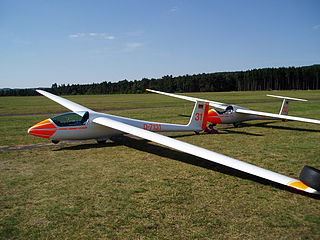
The Ace Junior Ace is a two-seat sports aircraft that has been offered by the Ace Aircraft Manufacturing Company in kit and plans form for home building since the early 1930s. It was designed by Orland Corben.
The Aero Boero AB-150 is an Argentine civil utility aircraft, developed in parallel with the AB-180 as a lower-cost, lower-powered version of that aircraft. Like the 180, it was produced by Aero Boero in long-range and agricultural variants.
The Aero Boero AB-210 is an Argentine civil utility aircraft, a development of the AB-180 with improved performance delivered by a fuel-injected engine. Unlike previous aircraft by this manufacturer, it also featured tricycle undercarriage, but retained the same general high-wing configuration. Only a single prototype was built, first flying on 22 April 1971.

The Ayres Thrush, formerly the Snow S-2, Aero Commander Ag Commander, and Rockwell Thrush Commander, is an American agricultural aircraft produced by Ayres Corporation and more recently by Thrush Aircraft. It is one of the most successful and long-lived agricultural application aircraft types in the world, with almost 2,000 sold since the first example flew 68 years ago. Typical of agricultural aircraft, it is a single-seat monoplane of conventional taildragger configuration. Originally powered by a radial piston engine, most examples produced since the 1980s have been turboprop-powered.

The PZL-Mielec M-20 Mewa is a licence-built version of the Piper PA-34 Seneca II manufactured in Poland by WSK PZL Mielec in a limited series from the 1980s.

The Air Tractor AT-500 is a family of agricultural aircraft that first flew in the United States on 25 April 1986, manufactured by Air Tractor Inc. Of monoplane low-wing, taildragger configuration, they carry a chemical hopper between the engine firewall and the cockpit. Compared with their predecessor, the AT-500 family featured a wingspan increase of 50 in, and an additional fuselage stretch of 22 in (56 cm), allowing for a larger chemical hopper. Almost all variants offer a widened "buddy" seat or a tandem seat for a passenger, observer, or loader; trainer aircraft with full dual controls have also been offered.

The Arctic Aircraft Arctic Tern is a bush plane that was produced in small numbers in Alaska in the 1970s and 1980s. It is a strengthened and modernised version of the Interstate Cadet of the 1940s. It is a high-wing braced monoplane with fixed tailwheel undercarriage. It has two seats in tandem, with the rear seat removable for added cargo carriage. It is also provided with a cargo loading door in the fuselage side to facilitate loading bulky items. Optional fittings included floats or skis in place of the wheeled undercarriage, and a ventral pod to carry extra cargo or fuel.
The Australian Autogyro Skyhook, originally flown as the Minty Skyhook, was a small, single seat autogyro marketed in kit form. Three versions were offered, with differing engines and cabin enclosures.

The Mudry CAP 20 is a French family of aerobatic competition single seater monoplanes.
The Hindustan Ardhra was a sailplane designed in India for pilot training by the government's Civil Aviation Department in the late 1970s as the ATS-1 Ardhra. It was a two-seat aircraft of conventional configuration and wooden construction. The Indian Air Force ordered fifty examples in the early 1980s to be produced by Hindustan Aeronautics and the type was approved for use for flying by cadets.

The Schleicher ASK 23 is a single-seat Club Class sailplane that was built by the German manufacturer Alexander Schleicher GmbH & Co.

The Fournier RF 5 is a two-seat motor glider designed by René Fournier.

The Hoffmann H40 was a prototype sport aircraft built in Germany in 1988. Designed by Wolf Hoffmann based on his Dimona motor-glider, it was a conventional, low-wing monoplane with side-by-side seating for two and tricycle undercarriage. The aircraft's high aspect ratio wings and T-tail were carried over from its motorglider heritage, but the span was shorter than that of the Dimona. Construction throughout was of composite materials. Hoffmann intended this aircraft to compete with sporting two-seaters such as the Grob G 115 and Robin ATL, but was unable to find the financial backing to bring the aircraft to market, despite a 30% share bought in the project by German pump manufacturer ABS.
The ICA IS-32 is an open class high-performance metal two-seat sailplane produced in Romania in the 1970s. A refinement of the IS-28B, it shared most of that aircraft's fuselage, mated to new wings and empennage. This new wing had a span of 20 metres, featuring interconnected ailerons and flaps, Schempp-Hirth-type airbrakes. It had no provision for water ballast. The monowheel undercarriage differed from the IS-28 in being fully retractable.

The Valentin Taifun is a two-seat self-launching sailplane designed and built by Valentin Flugzeugbau GmbH of Hasfurt, Germany.

The Scheibe SF 34 Delphin is a two-seat sailplane that was produced by Scheibe in Germany in the late 1970s and 1980s. Designed by Wolf Hoffmann and originally designated the SF H34, it was Scheibe's first unpowered aircraft of composite construction.
The Shenyang X-9 Jian Fan is a Chinese training glider built by the Shenyang Sailplane Factory at Shenyang.
The Chengdu X-7 Jian Fan is a Chinese basic trainer glider. First flying in 1966, at least 130 were built.

The Marske Monarch is a single-seat, high-wing, strut-braced, tailless ultralight glider and motor glider that was offered both as plans and a kit for amateur construction by Marske Aircraft.

The Politechnika Warszawska PW-2, also called the PW-2 Gapa, is a Polish lightweight high-wing, strut-braced single-seat, glider that was designed and built at the Warsaw University of Technology and also produced by DWLKK in the early 1990s. Total number of 19 gliders were built, including variant PW-2D bis.












